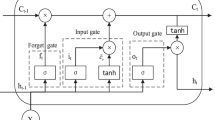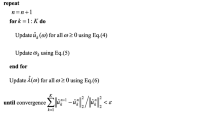Abstract
Water quality prediction is vital for solving water pollution and protecting the water environment. In terms of the characteristics of nonlinearity, instability, and randomness of water quality parameters, a short-term water quality prediction model was proposed based on variational mode decomposition (VMD) and improved grasshopper optimization algorithm (IGOA), so as to optimize long short-term memory neural network (LSTM). First, VMD was adopted to decompose the water quality data into a series of relatively stable components, with the aim to reduce the instability of the original data and increase the predictability, then each component was input into the IGOA-LSTM model for prediction. Finally, each component was added to obtain the predicted values. In this study, the monitoring data from Dayangzhou Station and Shengmi Station of the Ganjiang River was used for training and prediction. The experimental results showed that the prediction accuracy of the VMD-IGOA-LSTM model proposed was higher than that of the integrated model of Ensemble Empirical Mode Decomposition (EEMD), the integrated model of Complete Ensemble Empirical Mode Decomposition with Adaptive Noise (CEEMDAN), Nonlinear Autoregressive Network with Exogenous Inputs (NARX), Recurrent Neural Network (RNN), as well as other models, showing better performance in short-term prediction. The current study will provide a reliable solution for water quality prediction studies in other areas.

Similar content being viewed by others
References
Ahmed A N, Othman F B, Afan H A, Ibrahim R K, Elshafie A, Fai M C, Hossain M S, Ehteram M, Elshafie A (2019). Machine learning methods for better water quality prediction. Journal of Hydrology (Amsterdam), 578: 124084
Babbar R, Chaubey I (2021). Multiple regression analysis for predicting few water quality parameters at unmonitored sub-watershed outlets in the St. Joseph River basin, USA. Geocarto International, (11): 1–27
Bai J, Zhao J, Zhang Z Y, Tian Z Q (2022). Assessment and a review of research on surface water quality modeling. Ecological Modelling, 466: 109888
Bi J, Lin Y Z, Dong Q X, Yuan H T, Zhou M C (2021). Large-scale water quality prediction with integrated deep neural network. Information Sciences, 571: 191–205
Brown L C, Barnwell T O (1987). The enhanced stream water quality models qual2e and qual2e-uncas: documentation and user manual. Washington DC: Environmental Research Laboratory Office of Research and Development U.S. Environment Protection Agency
Burigato Costa C M S, da Silva Marques L, Almeida A K, Leite I R, de Almeida I K (2019). Applicability of water quality models around the world: a review. Environmental Science and Pollution Research, 26(36): 36141–36162
Chen Y, Zou R, Han S, Bai S, Faizullabhoy M, Wu Y, Guo H (2017). Development of an integrated water quality and macroalgae simulation model for Tidal Marsh eutrophication control decision support. Water (Basel), 9(4): 277
Chueh Y Y, Fan C, Huang Y Z (2020). Copper concentration simulation in a river by swat-wasp integration and its application to assessing the impacts of climate change and various remediation strategies. Journal of Environmental Management, 279(2–4): 111613
Deng W, Xu J, Gao X Z, Zhao H (2022a). An enhanced MSIQDE algorithm with novel multiple strategies for global optimization problems. IEEE Transactions on Systems, Man, and Cybernetics. Systems, 52(3): 1578–1587
Deng W, Xu J, Zhao H, Song Y (2022b). A novel gate resource allocation method using improved PSO-based QEA. IEEE Transactions on Intelligent Transportation Systems, 23(3): 1737–1745
Deng Y, Zhou X, Shen J, Xiao G, Hong H, Lin H, Wu F, Liao B Q (2021). New methods based on backpropagation (BP) and radial basis function (RBF) artificial neural networks (ANNS) for predicting the occurrence of haloketones in tap water. Science of the Total Environment, 772(6): 145534
Diebold F, Mariano R (1995). Comparing predictive accuracy. Journal of Business & Economic Statistics, 13(3): 253–263
Ding Y R, Cai Y J, Sun P D, Chen B (2014). The use of combined neural networks and genetic algorithms for prediction of river water quality. Journal of Applied Research and Technology, 12(3): 493–499
Dragomiretskiy K, Zosso D (2014). Variational mode decomposition. IEEE Transactions on Signal Processing, 62(3): 531–544
Ewaid S H, Abed S A, Kadhum S A (2018). Predicting the Tigris River water quality within Baghdad, Iraq by using water quality index and regression analysis. Environmental Technology & Innovation, 11: 390–398
Feng X B, Zhong J, Yan R, Zhou Z H, Tian L, Zhao J, Yuan Z Y (2022). Groundwater radon precursor anomalies identification by EMD-LSTM model. Water (Basel), 14(1): 69
Hamilton D P, Schladow S G (1997). Prediction of water quality in lakes and reservoirs. Part I, Model description. Ecological Modelling, 96(1–3): 91–110
Han K Y, Kim S H, Bae D H (2001). Stochastic water quality analysis using reliability method. Journal of the American Water Resources Association, 37(3): 695–708
He M, Wu S F, Huang B B, Kang C X, Gui F L (2022). Prediction of total nitrogen and phosphorus in surface water by deep learning method based on multi-scale feature extraction. Water (Basel), 14(10): 1643
Hochreiter S, Schmidhuber J (1997). Long short-term memory. Neural Computation, 9(8): 1735–1780
Huang N E, Shen Z, Long S R, Wu M C, Shih H H, Zheng Q, Yen N C, Tung C C, Liu H H (1998). The empirical mode decomposition and the Hilbert spectrum for nonlinear and non-stationary time series data analysis. Proceedings Mathematical Physical & Engineering Sciences, 454(1971): 903–995
Huang Y, Chen J, Duan Q, Feng Y, Luo R, Wang W, Liu F, Bi S, Lee J (2022). A fast antibiotic detection method for simplified pretreatment through spectra-based machine learning. Frontiers of Environmental Science & Engineering, 16(3): 38
Ji Z, Wang Z, Deng X, Huang W, Wu T (2019). A new parallel algorithm to solve one classic water resources optimal allocation problem based on inspired computational model. Desalination and Water Treatment, 160: 214–218
Jiang Y (2015). China’s water security: current status, emerging challenges and future prospect. Environmental Science and Pollution Research International, 54: 106–125
Jin T, Cai S, Jiang D, Liu J (2019). A data-driven model for real-time water quality prediction and early warning by an intergration method. Environmental Science and Pollution Research International, 26(29): 30374–30385
Kim J, Lee T, Seo D (2017). Algal bloom prediction of the lower Han River, Korea using the EFDC hydrodynamic and water quality model. Ecological Modelling, 366: 27–36
Lan Y X (2021). Grasshopper optimization algorithm based on chaos and cauchy mutation and feature selection. Microelectronics & Computer, 38(11): 21–30
Leong W C, Bahadori A, Zhang J, Ahmad Z (2021). Prediction of water quality index (WQI) using support vector machine (SVM) and least square-support vector machine (LS-SVM). International Journal of River Basin Management, 19(2): 149–156
Li X, Sha J, Wang Z L (2017). A comparative study of multiple linear regression, artificial neural network and support vector machine for the prediction of dissolved oxygen. Nordic Hydrology, 48(5): 1214–1225
Li Z, Peng F, Niu B, Li G, Wu J, Miao Z (2018). Water quality prediction model combining sparse auto-encoder and LSTM network. IFAC-PapersOnLine, 51(17): 831–836
Liu Y, Zhang Q, Song L, Chen Y (2019). Attention-based recurrent neural networks for accurate short-term and long-term dissolved oxygen prediction. Computers and Electronics in Agriculture, 165: 104964
Mohammed H, Tornyeviadzi H M, Seidu R (2021). Modelling the impact of weather parameters on the microbial quality of water in distribution systems. Journal of Environmental Management, 284(1): 111997
Najafzadeh M, Niazmardi S (2021). A novel multiple-kernel support vector regression algorithm for estimation of water quality parameters. Natural Resources Research, 30(5): 3761–3775
Oki T, Kanae S (2006). Global hydrological cycles and world water resources. Science, 313(5790): 1068–1072
Rajaee T, Khani S, Ravansalar M (2020). Artificial intelligence-based single and hybrid models for prediction of water quality in rivers: a review. Chemometrics and Intelligent Laboratory Systems, 200: 103978
Saremi S, Mirjalili S, Lewis A (2017). Grasshopper optimization algorithm: theory and application. Advances in Engineering Software, 105: 30–47
Seo D, Kim M, Ahn J H (2012). Prediction of chlorophyll-a changes due to weir constructions in the Nakdong River using EFDC-WASP modelling. Environmental Engineering Research, 17(2): 95–102
Toro D M D, Fitzpatrick J J, Thomann R V (1983). Documentation for water quality analysis simulation program (WASP) and model verification program (MVP). Proceedings of the Society for Photo-Instrumentation Engineers, 34(5): 4–10
Vaheddoost B, Aksoy H (2021). Regressive-stochastic models for predicting water level in Lake Urmia. Hydrological Sciences Journal, 66(13): 1892–1906
Vörösmarty C J, McIntyre P B, Gessner M O, Dudgeon D, Prusevich A, Green P, Glidden S, Bunn S E, Sullivan C A, Liermann C R, Davies P M (2010). Global threats to human water security and river biodiversity. Nature, 467(7315): 555–561
Wang Z, Deng A, Wang D, Wu T (2022). A parallel algorithm to solve the multiple travelling salesmen problem based on molecular computing model. International Journal of Bio-Inspired Computation, 20(3): 160–171
Wang Z, Wu X, Wang H, Wu T (2021). Prediction and analysis of domestic water consumption based on optimized grey and Markov model. Water Science and Technology: Water Supply, 21(7): 3887–3899
Wu J, Li Z, Zhu L, Li G, Niu B, Peng F (2018). Optimized bp neural network for dissolved oxygen prediction. IFAC-PapersOnLine, 51(17): 596–601
Wu J, Wang Z (2022). A hybrid model for water quality prediction based on an artificial neural network, wavelet transform, and long short-term memory. Water (Basel), 14(4): 610
Xu J, Xu M, Zhao Y X, Wang S F, Tao M H, Wang Y G (2021). Spatial-temporal distribution and evolutionary characteristics of water environment sudden pollution incidents in China from 2006 to 2018. Science of the Total Environment, 801: 149677
Xu L, Shen J, Marinova D, Guo X, Sun F, Zhu F (2013). Changes of public environmental awareness in response to the Taihu blue-green algae bloom incident in China. Environment, Development and Sustainability, 15(5): 1281–1302
Yao R, Guo C, Deng W, Zhao H (2022). A novel mathematical morphology spectrum entropy based on scale-adaptive techniques. ISA Transactions, 126: 691–702
Yu R L, Zhang C (2021). Early warning of water quality degradation: a copula-based Bayesian network model for highly efficient water quality risk assessment. Journal of Environmental Management, 292: 112749
Zhang J, Zhu Y, Zhang X, Ye M, Yang J (2018). Developing a long short-term memory (LSTM) based model for predicting water table depth in agricultural areas. Journal of Hydrology (Amsterdam), 561: 918–929
Zhou Z, Lin C, Li S, Liu S, Li F, Yuan B (2022). Four kinds of capping materials for controlling phosphorus and nitrogen release from contaminated sediment using a static simulation experiment. Frontiers of Environmental Science & Engineering, 16(3): 29
Zhu Z, Oberg N, Morales V M, Quijano J C, Landry B J, Garcia M H (2016). Integrated urban hydrologic and hydraulic modelling in Chicago, Illinois. Environmental Modelling & Software, 77: 63–70
Acknowledgements
This work was supported by the Zhejiang Provincial Natural Science Foundation of China (No. LY23H180001), the Open Research Fund of State Key Laboratory of Simulation and Regulation of Water Cycle in River Basin, the China Institute of Water Resources and Hydropower Research (No. IWHR-SKL-201905) and the National Natural Science Foundation of China (No. 11701363).
Author information
Authors and Affiliations
Corresponding author
Additional information
Data Accessibility Statement
The data and code that support the findings of this study are available from the corresponding author, Tunhua Wu, upon reasonable request.
Highlights
• A novel VMD-IGOA-LSTM model has proposed for the prediction of water quality.
• Improved model quickly converges to the global optimal fitness and remains stable.
• The prediction accuracy of water quality parameters is significantly improved.
Rights and permissions
About this article
Cite this article
Wang, Z., Wang, Q. & Wu, T. A novel hybrid model for water quality prediction based on VMD and IGOA optimized for LSTM. Front. Environ. Sci. Eng. 17, 88 (2023). https://doi.org/10.1007/s11783-023-1688-y
Received:
Revised:
Accepted:
Published:
DOI: https://doi.org/10.1007/s11783-023-1688-y




